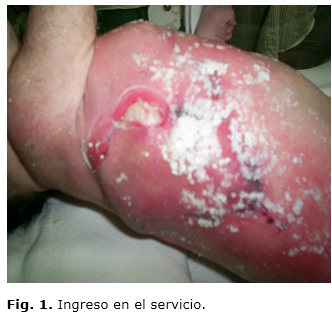Type II Necrotizing Fasciitis as a Dermatological Emergency in a Newborn
Keywords:
Necrotizing fascitis, Sepsis, Newborn infant.Abstract
Introduction: necrotizing fasciitis is a rapidly progressive infection of the skin and soft tissues, often associated with a significant systemic toxicity. It is considered a dermatological emergency.
Clinical case: the case of a newborn with 12 days of life and with no pathological perinatal history is presented; admitted for special neonatal cares service due to a severe soft tissue infection in the thoracic region that evolved to shock. Clinical, microbiology and chemistry testing confirmed the diagnosis of a necrotizing fasciitis. In its evolution, it was required a multidisciplinary and immediate aggressive surgical treatment by burnt specialists; which consisted of resection, with broad and complete removal of all necrotic tissue. After one month of life, we decided to perform a free skin graft taken from the mother herself (homologous graft). The patient was discharged from hospital after 3 months, with a full recovery and no evidence of organ damage.
Conclusions: newborn necrotizing fasciitis is considered an unusual dermatological emergency.
Downloads
References
1. Suárez Fernández R. Urgencias en dermatología. Más Dermatología [Internet]. 2012 [citado 12 Agost 2013]; 16[aprox. 4.]. Disponible en: http://dialnet.unirioja.es/descarga/articulo/3827703.pdf
2. Parra Caballero P, Pérez Esteban S, Patiño Ruiz ME, Castañeda Sanz S, García Vadillo JA. Actualización en fascitis necrotizante. Semin Fund Esp Reumatol [Internet]. 2012 [citado 12 Agost 2013]; 13(2) [aprox. 9.]. Disponible en: http://apps.elsevier.es/watermark/ctl_servlet?_f=10&pident_articulo=90135099&pident_usuario=0&pcontactid=&pident_revista=274&ty=
144&accion=L&origen=zonadelectura&web=http: //zl.elsevier.es&lan=es&fichero=274v13n02a90135099pdf001.pdf
3. Iwata K. An autopsy case of necrotizing fasciitis with rapidly progressive purpura caused by hemolytic streptococcal infection in a patient with rheumatoid arthritis. Mod Rheumatol [Internet]. 2012 [citado 28 Jul 2013]; 21: [aprox. 4p.]. Disponible en: http://web.ebscohost.com/ehost/detail?vid=5&sid=6106aa2d-8929-4777-908e ae78f62857e0%40sessionmgr13&hid=10&bdata=Jmxhbmc9ZXMmc2l0ZT1laG9zdC1saXZl#db=aph&AN=69625011
4. Steffen G, Siqueira EJ, Oliveira MP, Escobar PD. Fasceíte necrotizante após aplicação de injeção intramuscular. Rev Bras Cir Plást [Internet]. 2012 [citado 28 Jul 2013]; 27(4): [aprox. 1.]. Disponible en: http://www.scielo.br/scielo.php?script=sci_arttext&pid=S1983-51752012000400033&lang=pt
5.Ching L, Liang K, Kuo P, Wei H, Tsan H, Chao Y. Prognostic factors and monomicrobial necrotizing fasciitis: gram-positive versus gram-negative Pathogens. BMC Infectious Diseases [Internet]. 2012 [citado 22 Jul 2013]; 11(5): [aprox. 8p.]. Disponible en: http://web.ebscohost.com/ehost/pdfviewer/pdfviewer?sid=6106aa2d-8929-4777-908e ae78f62857e0%40sessionmgr13&vid=5&hid=10
6. Canan G, Hakan B, Özge S, Ergin S, Mehmet O?uz Y, Ahmet K, Can I. Periorbital Necrotizing Fasciitis Caused by Community-Associated Methicillin-Resistant Staphylococcus Aureus Periorbital Necrotizing Fasciitis. Orbit [Internet]. 2010 [citado 12 Jul 2013]; 29(6): [aprox. 3p.]. Disponible en: http://web.ebscohost.com/ehost/pdfviewer/pdfviewer?vid=4&sid=6106aa2d-8929-4777-908e-ae78f62857e0%40sessionmgr13&hid=10
7. Parra Caballero P, Pérez Esteban S, Patiño Ruiz ME, Castañeda Sanz S, García Vadillo JA. Actualización en fascitis necrotizante. Semin Fund Esp Reumatol [Internet]. 2012 [citado 12 Agost 2013]; 13(2): [aprox. 9.]. Disponible en: http://apps.elsevier.es/watermark/ctl_servlet?_f=10&pident_articulo=90135099&pident_usuario=0&pcontactid=&pident_revista=274&ty=
144&accion=L&origen=zonadelectura&web=http://zl.elsevier.es&lan=es&fichero=274v13n02a90135099pdf001.pdf

Published
How to Cite
Issue
Section
License
Authors who have publications with this journal agree to the following terms: Authors will retain their copyrights and grant the journal the right of first publication of their work, which will be publication of their work, which will be simultaneously subject to the Creative Commons Attribution License (CC-BY-NC 4.0) that allows third parties to share the work as long as its author and first publication in this journal are indicated.
Authors may adopt other non-exclusive license agreements for distribution of the published version of the work (e.g.: deposit it in an institutional telematic archive or publish it in a volume). Likewise, and according to the recommendations of the Medical Sciences Editorial (ECIMED), authors must declare in each article their contribution according to the CRediT taxonomy (contributor roles). This taxonomy includes 14 roles, which can be used to represent the tasks typically performed by contributors in scientific academic production. It should be consulted in monograph) whenever initial publication in this journal is indicated. Authors are allowed and encouraged to disseminate their work through the Internet (e.g., in institutional telematic archives or on their web page) before and during the submission process, which may produce interesting exchanges and increase citations of the published work. (See The effect of open access). https://casrai.org/credit/


